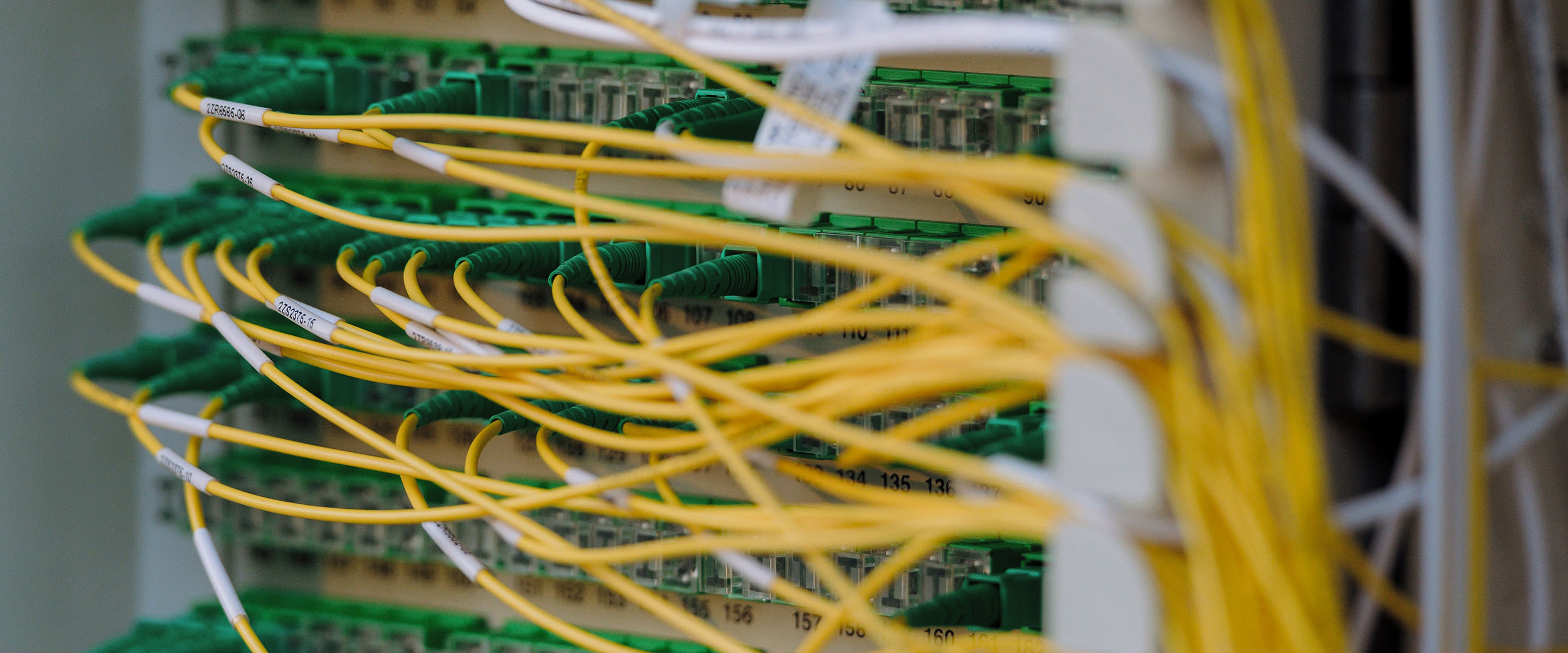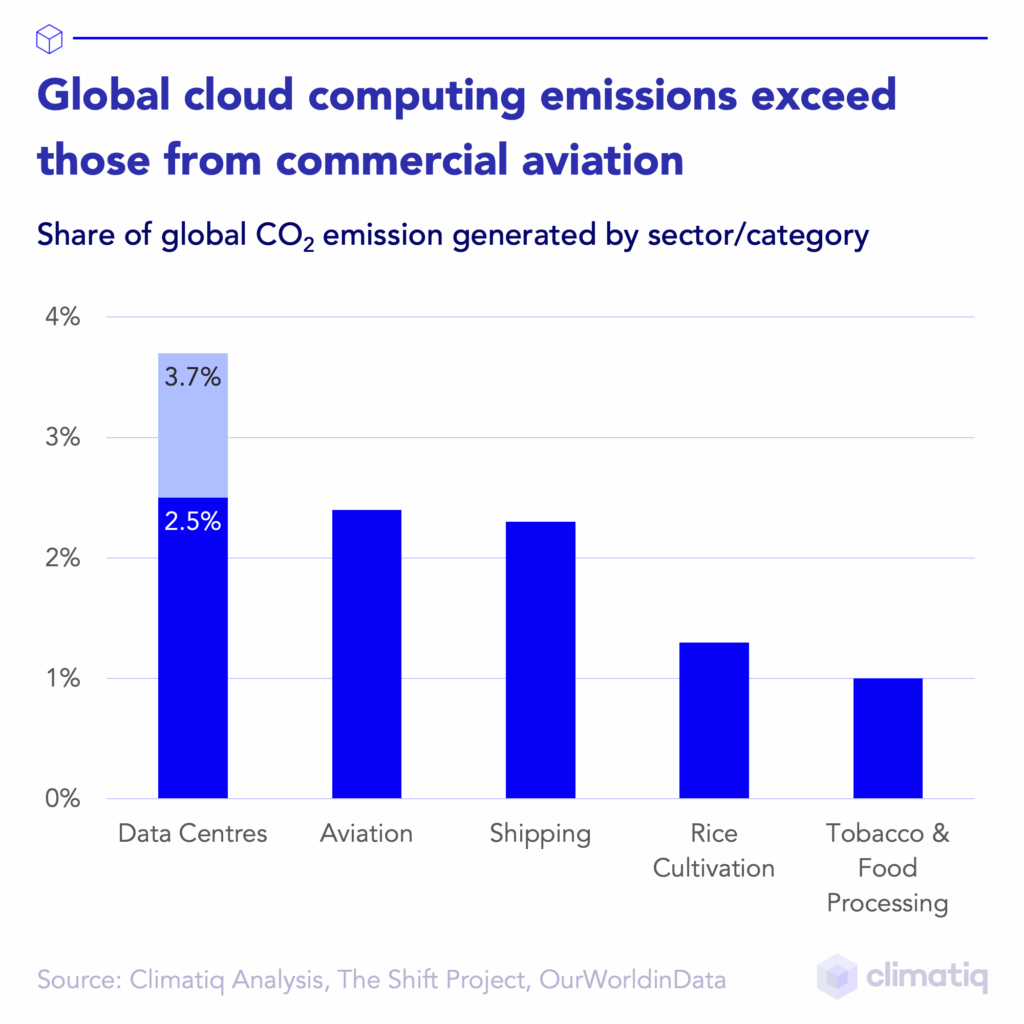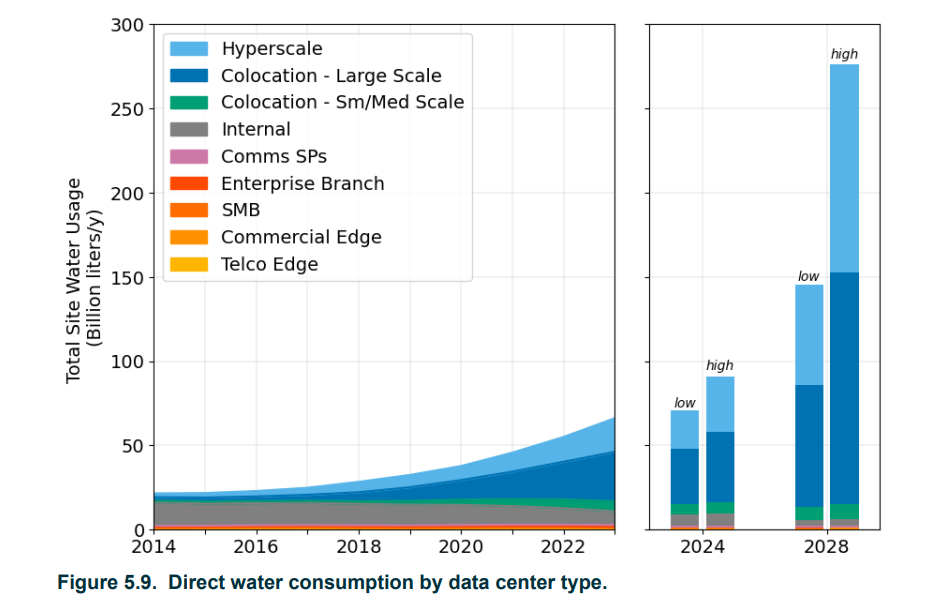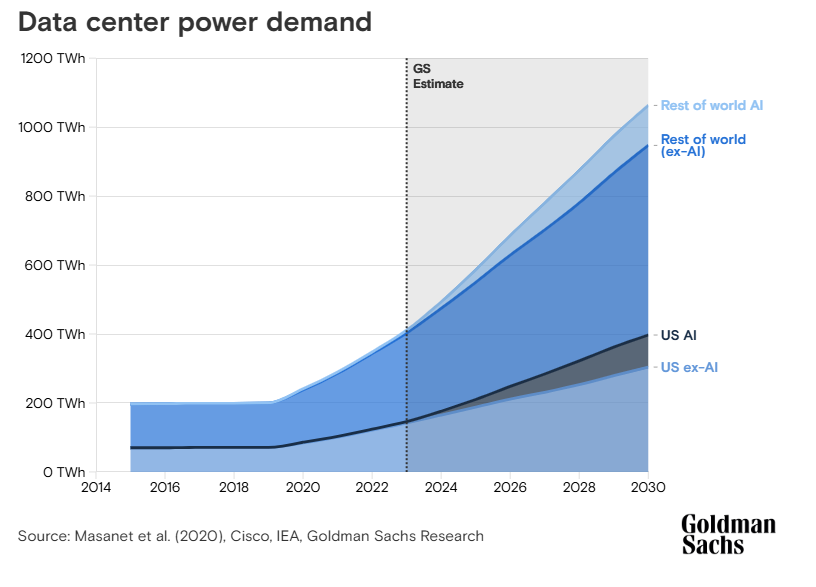Decarbonizing Data Centers


🌍 Carbon markets can feel overwhelming—fragmented data, limited transparency, and conflicting advice make it hard to know where to start. In this webinar, our experts give a clear, practical introduction to the VCM.
How to accurately measure and effectively reduce emissions from data center operations.
As the world becomes increasingly digital, the demand for data centers has surged quickly. These facilities, which power all the cloud computing to streaming services, are among the most energy-intensive infrastructures in the global economy. The Global cloud computing emissions now exceed those from commercial aviation, according to Climatiq (see graph below). Data centers consumed about 4.4% of total US electricity in 2023, and the US Department of Energy (DOE) projects they will consume about 6.7% to 12% by 2028. The total data center electricity usage will climb from 176 terrawatt hours (TWh) in 2023 to an estimated increase between 325 and 580 TWh by 2028.

Source: Climatiq.io
Many of the facilities heavily rely on water for cooling, which can strain local water resources, mainly in regions facing water scarcity. According to a report from Lawrence Berkeley National Laboratory, data centers in 2023 consumed about 17.4 gallons of water with the number expected to double by 2028. With the carbon footprint and water consumption of data centers increasing at a rapid pace, the scrutiny over the environmental impacts and the associated greenhouse gas (GHG) emissions has also increased significantly.
Additionally, given that the biggest drivers of data center growth are hyperscalers like Microsoft, Google etc. who have strong climate commitments, decarbonizing data centers is a matter of strategic importance and not just an operational challenge.

Source: Escholarship.org
Estimating Data Center Emissions
Understanding the Carbon Footprint of Data Centers
There is an age old saying “You can’t manage what you don’t measure” and thus the first thing is for a data center to understand its environmental footprint. Data centers require vast amounts of electricity to power servers, storage systems, and networking equipment, as well as to keep them reliably cool and operational 24/7. According to The MIT Press Reader, in most data centers, cooling accounts for more than 40% of the electricity usage. The carbon footprint of a data center is largely driven by the amount of electricity it consumes during operation. This high power demand continues growing rapidly alongside the rise in global data traffic, cloud adoption, and computationally intensive workloads.

Source: Goldmansachs.com
Accurately estimating emissions from data center operations depends heavily on the ownership model of the data center. A company’s model of ownership such as owning, leasing colocation space, or utilizing cloud services, directly affects how its emissions are distributed across Scope 1, 2, and 3 categories. Each ownership model requires a different approach to allocate energy use and reporting, making it critical to understand ownership structures when building a complete and robust emission inventory.
Data centers can be owned and operated under several models. They are broadly classified into the following categories based on their ownership type:
- Enterprise: A facility generally operated under the ownership or lease of a single organization.
- Colocation: A space usually rented out that can host an organization’s hardware and IT equipment, typically having other data center requirements such as power, cooling, and security. Organizations without space for in-house data centers usually rely on these types of facilities.
- Hyperscale: A facility that handles extensive data with massive computational needs and has the required equipment and space to scale up rapidly if needed.

Source: Prnewswire.com
Scope 1, 2, and 3 emissions are classified differently depending on the ownership model of a data center. The following table shows the breakdown of Scope 1, 2, and 3 emissions for a fully owned and operated data center.
Scope 1 emissions are direct emissions owned or controlled by the data center operator. Scope 2 emissions are the indirect emissions from the generation of electricity purchased and consumed by the data center operator. Scope 2 is often the most emission intensive scope for data centers. Scope 3 emissions are the other indirect emissions that occur in the value chain both upstream and downstream
If the ownership type is colocation or leased from a third-party operator, most of the energy-related emissions would fall under Scope 3 for the lessee and Scope 1 and Scopes 2 for the third-party operator.
“As the global demand for digital services accelerates, data centers are becoming a rapidly growing source of energy consumption and environmental impacts. Decarbonizing data centers is thus a critical step in aligning the industry with climate goals.”
Sathya Narayanan, Analyst, Climate Services
Key Metrics
With Scope 1, 2 and 3 boundaries mapped to each ownership model, the next step would be to gauge how efficiently a data center utilizes its resources. To effectively manage and reduce environmental impact of data centers, the industry relies on a set of standardized performance metrics that quantify resource utilization.These key metrics allow operators and stakeholders to assess operational efficiency, compare performance across facilities and track progress over time. The following are three industry standard key metrics which quantify the environmental impacts of a data center.
Power Usage Effectiveness (PUE): Measures how efficiently a data center uses energy. It compares the total electricity consumed by the facility to the electricity used specifically by the hardware and IT equipment in the data center, highlighting the overhead energy used for cooling, lighting, and other infrastructure.
Carbon Usage Effectiveness (CUE): Measures the environmental impact in terms of carbon emissions from all emitting sources of the data centers relative to the energy consumed by hardware and IT equipment. CUE measures the total emissions associated per unit of energy consumption by the hardware and IT equipment.
Water Usage Effectiveness (WUE): Measures the amount of water used by a data center for cooling purposes relative to the energy consumed by its hardware and IT equipment.
Data centers employ water-based cooling solutions to reduce electricity consumption, lowering the PUE. However, this increases water consumption, which has its own environmental footprint, from activities like pumping, sourcing and treatment. Optimizing for lower PUE without considering water usage can move the environmental impact from electricity to water. Water Usage Effectiveness (WUE) is used to quantify water consumption.
Decarbonizing Data Centers
While the key metrics discussed help track resource performance, they do not fully capture the urgency of the climate challenge. As the global demand for digital services accelerates, data centers are becoming a rapidly growing source of energy consumption and environmental impacts. Decarbonizing data centers is thus a critical step in aligning the industry with climate goals. Without targeted action to reduce reliance on fossil fuels, optimize operations and address emissions across the value chain, the industry risks undermining broader sustainability efforts. Key areas outlined below are instrumental in advancing data center decarbonization efforts.
Energy Efficiency and Server Consolidation
Energy efficiency is one of the most cost-effective strategies for decarbonizing data centers. By optimizing how energy is used within IT and facility infrastructure, data centers can significantly reduce their carbon footprint without compromising performance.
Through methods like server consolidation, workloads can be transferred from multiple underutilized servers to fewer, higher-efficiency machines. This can reduce direct and indirect energy use through reduced cooling requirements, reducing overall power consumption.
Smart Infrastructure Upgrades
Machine learning technologies can be used to analyze real-time environmental and operational data to adjust airflow or temperature dynamically and predict hotspots and increase cooling beforehand to optimize energy consumption.
Modern, efficient CPUs and GPUs can replace older, less efficient hardware systems. New hardware can also help utilize advanced power management features and support newer software versions. These efficiency upgrades not only lower emissions and operational costs but also prepare data centers for a future where energy and carbon constraints become strict.
Cooling systems are a major source of emissions in data centers due to their high energy demand. As servers and IT equipment generate significant heat during operation, continuous cooling is necessary to maintain optimal performance and prevent hardware failure. Data centers are increasingly focused on balancing WUE and PUE to optimize both environmental impact and operational efficiency. While reducing PUE often involves energy-intensive cooling methods that may increase water consumption, operators are now exploring technologies that minimize both energy and water use, such as hybrid cooling and heat reuse systems.
Renewable Energy
Making a shift to renewable energy is the most impactful step toward decarbonizing data centers. Since computing infrastructure operates 24/7, powering it with clean energy sources is essential to achieving sustainability goals. This can be done through on-site generation via solar panels, wind turbines, or other renewable technologies, directly powering the facilities, or through offsite renewable energy procurement through PPAs and/or Renewable Energy Certificates (RECs).
Design and Construction
Thoughtful design and construction practices, including selection of materials, building design, and ventilation designs, can impact the energy consumption and therefore the emissions from facility operations. Certifying new data centers under frameworks, such as LEED (Leadership in Energy and Environmental Design), BREEAM (Building Research Establishment Environmental Assessment method), or Energy Star for data centers, ensures adherence to best practices in areas such as site selection, water efficiency, material selection, energy use, and indoor environmental quality.
Industry Highlights
Weather patterns and forecasts can also be integrated into these technologies to reduce energy and cooling needs. Google Deep Mind is one example where machine learning was utilized to reduce the amount of energy used for cooling by 40%, which translates to a 15% reduction in overall PUE.
Conclusion
Data Centers have a significant impact on the environment due to their high energy use. While progress is being made in improving efficiency and sourcing renewable power, the industry must accelerate its shift towards energy efficiency and including modern technology to analyze cooling demands and reduce energy consumption. While a lot can be done to decarbonize data centers, current technologies alone cannot bring data centers to net-zero emissions. To close this gap many data center operators rely on high quality carbon credits to move closer to climate neutrality.
If you need help understanding the growing demands for sustainability in data centers, purchase high quality offset credits and meet your sustainability goals, contact us to get started.
The first step is to accurately measure your emissions across Scope 1, 2, and 3. This includes gathering energy use data, understanding your facility’s operational model (enterprise, colocation, or hyperscale), and benchmarking performance using metrics like PUE, CUE, and WUE. Once you know where and how emissions are occurring, you can identify the most impactful reduction strategies.
If your data center operates primarily on purchased electricity, Scope 2 is likely your largest source of emissions. This is especially true for high-density computing environments. An energy audit or emissions inventory can confirm this and help prioritize solutions like improving energy efficiency or transitioning to renewable electricity.
Yes. Even if you don’t own the facility, you can reduce emissions by selecting colocation providers with strong sustainability credentials, requesting renewable energy-backed services, and optimizing your own IT hardware for energy efficiency. You may also be able to negotiate access to energy usage data to track and improve your Scope 3 emissions performance.
Hybrid cooling systems, heat reuse strategies, and machine learning tools that predict and optimize cooling demand can help lower your Power Usage Effectiveness (PUE) without increasing your water footprint. Balancing PUE and WUE requires a systems-level approach to avoid simply shifting the environmental impact from one resource to another.
CarbonBetter can help you assess your emissions profile, identify key reduction opportunities, and develop a tailored roadmap for meeting sustainability goals. We offer guidance on renewable energy procurement, energy efficiency upgrades, ESG disclosures, and stakeholder communications—meeting you wherever you are on your journey to net zero.

About the Authors
Sathya Narayanan is a Climate Analyst on CarbonBetter’s Climate Services team, specializing in client delivery, sustainability research, and greenhouse gas (GHG) accounting. Sathya holds an MS in Sustainable Engineering from Arizona State University and a BTech in Civil Engineering from SASTRA University in India.

Pankaj Tanwar is Managing Director of Climate Services at CarbonBetter. He has experience leading Fortune 100 companies through their sustainability journeys, including sustainability driven growth in the food industry. Pankaj holds an MBA from Northwestern University’s Kellogg School of Management and a BTech in Mechanical Engineering from the Indian Institute of Technology, Kanpur.


